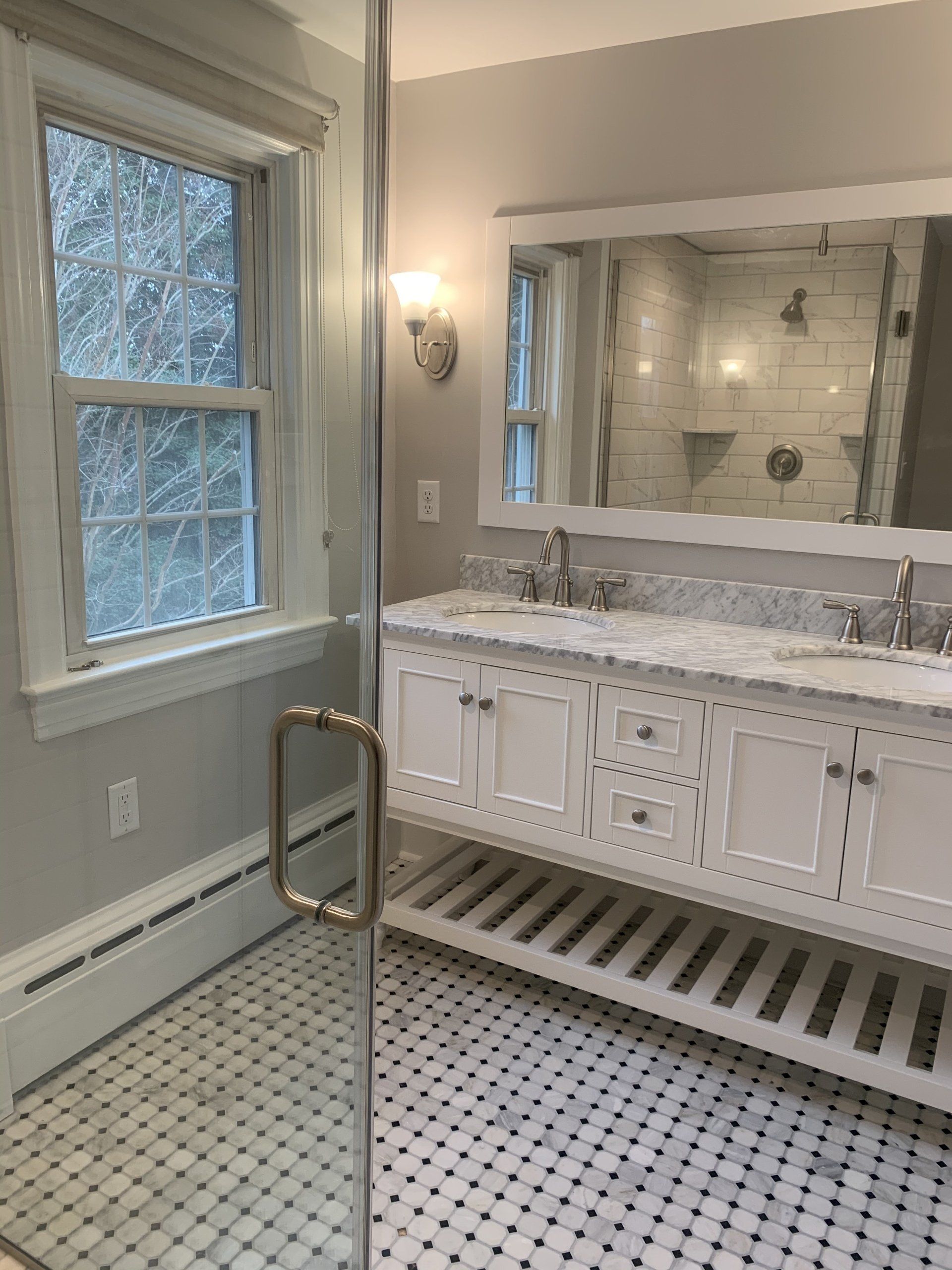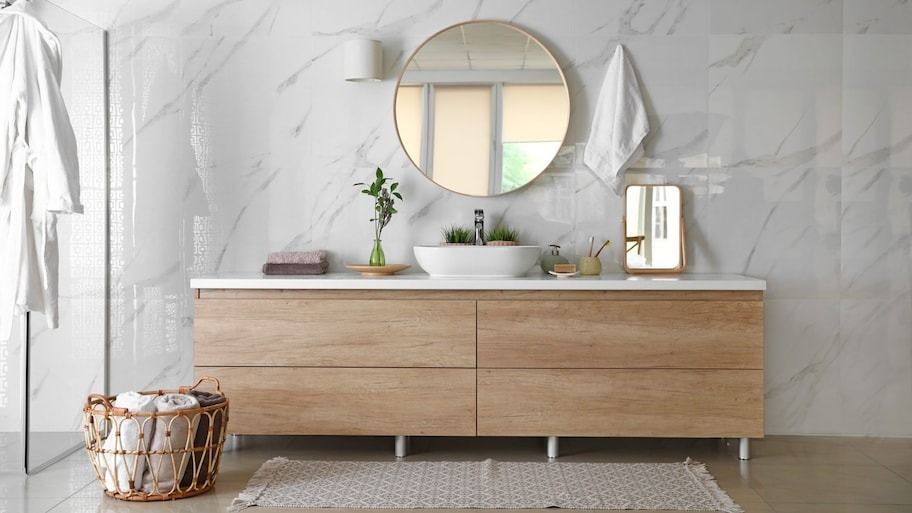How to Get Rid of Household Mold
You can procrastinate about some cleaning tasks, but when it comes to mold, it’s better to take care of it sooner rather than later. Mold can cause health problems and destroy whatever it grows on. The spores of mold fungi commonly float through the air, and when they adhere to damp surfaces and start to grow, they can gradually consume the surface. The key is to get the cleanup done before that happens.
Mold produces allergens that can cause reactions in some people, including hay fever-type symptoms. Even mold treated by a chemical or biocide can still cause allergic reactions, so in addition to killing mold, it also needs be removed, the U.S. Environmental Protection Agency says. Here’s how to work with a pro to get rid of mold in your house, and how to prevent mold from forming in the first place.
Pristine Interiors by Eva Priest
Where Mold Is Most Common
A leaky roof or plumbing, flood damage, or indoor humidity that’s too high and without proper ventilation can all lead to mold problems. Unmitigated flood and water damage can lead to mold growth in as little as 24 hours, according to Gold Coast Flood Restorations in San Diego.
Anyplace that remains damp and unventilated is a potential mold-forming zone. “Anywhere water travels” in a structure is vulnerable to mold, says Austin Reid, co-owner of Mold Masters in Southern California.
That includes areas where major plumbing arteries are located, crawl spaces with drains, walls plumbed from bathroom to bathroom and between floors. Incorrectly sealed tubs and faulty construction can cause water to seep in crevices and create big problems over time, Reid says.
Find a mold specialist on Houzz
Regions where the weather tends to be damp or humid can be mold hot spots — but arid areas are not immune. Buildings that are tightly sealed may lack adequate ventilation, which can lead to moisture buildup, says the EPA.
Mildew is another fungi-produced coating that can form on damp surfaces. Mildew usually grows in a flat pattern and appears powdery and white or gray. Mold is darker in color, usually black or green, and penetrates the surface of what it’s growing on. You may follow the same cleaning steps below to get rid of mold and mildew.
How to Clean Your Windows and Keep Them Streak-Free
Most Mold-Prone Areas
Most Mold-Prone Areas
- Basements or cellars
- Under kitchen and bathroom sinks
- Under or behind refrigerators
- Behind walls that house plumbing
- Around air-conditioning units
- Baseboards or around windowsills
- Under carpeting
Hidden Mold
Mold often goes undetected behind wallpaper. In the photo shown here, an inspector from Mold Inspection & Testing in Chicago found mold growing behind wallpaper and baseboards in a foreclosed home. Exterior walls aren’t a good location for wallpaper, says the company, because of big temperature changes between indoors and outdoors. In addition, glue can act as a nutrient to feed mold.
To Clean or Throw Away?
If the mold is on a porous surface, such as carpeting, ceiling tiles, drywall or wallpaper, the items might have to be thrown away since the mold may be impossible to remove.
Mold will often cultivate on the backside of drywall inside wall cavities before it becomes evident on the surface, according to Gold Coast Flood Restorations.
How to Get Rid of Mold Yourself
Here are some options for simple surface mold removal from Indoor Science Consultants and Technicians, a mold testing organization with locations across the U.S.
- Bleach. Mix 1 cup bleach with enough water to make 1 gallon. Put the solution in a spray bottle, or spread it with a sponge or cloth. There’s no need to rinse.
- Borax. Mix 1 cup borax with enough water to make 1 gallon. Borax is less harsh-smelling and corrosive than bleach. Apply the solution to the surface and scrub with a brush; don’t rinse. Wipe the surface dry.
- Vinegar. Use full-strength vinegar in a spray bottle. Spray the affected area and wipe off.
- Ammonia. This is suitable for killing mold on smooth, nonporous surfaces. Never use it with bleach. Treat the area with a solution of equal parts ammonia and water, leave on for 10 minutes, and rinse with water.
- Hydrogen peroxide. Spray full-strength hydrogen peroxide on the moldy surface and let it sit for 10 minutes to loosen the mold. Wipe the surface and don’t rinse.
- Baking soda. Mix one-half teaspoon baking soda in 1 gallon water and scrub the moldy surface, then rinse with water. This is particularly useful for killing mold on upholstery.
- Tea tree oil. Use 1 teaspoon tea tree oil per cup of water and spray on the surface. Leave it on for a few minutes and then wipe off.
Note: When cleaning up mold, the EPA advises wearing rubber gloves, goggles and possibly an N-95 respirator to avoid breathing in mold. The agency also cautions against using bleach or biocides (mold-killing chemicals) because they can cause severe reactions in some people.
Shop for cleaning supplies
When to Call a Pro to Clean Up Mold
Wiping down mildew in damp areas is always a good idea, but how do you know when it’s time to bring in a professional? The EPA advises using a mold remediation expert if the affected area is larger than about 10 square feet (roughly 3 by 3 feet).
But, depending on your comfort level, even a patch that’s 1 square foot may be enough for someone sensitive to mold to call in a pro, says Reid of Mold Masters.
Testing for Mold
Chronic allergy-type health problems or mildewy odors mean it’s time to consider more extensive mold treatment. Start by using a mold testing company, which will take samples, send them to a lab, and obtain a report on mold levels and species. Use a company that does testing only, to avoid a conflict of interest.
How to Get Rid of a Serious Mold Buildup
For major mold cleanup, Reid says his company uses a plant-based, thyme oil mildicide that’s commonly used in hospitals. Professionals should follow EPA guidelines.
If a mold that produces toxins, such as Stachybotrys chartarum (black mold) is found, you should always call a mold remediation company and not try to clean it yourself.
Black mold, which can permanently damage your health, often has a slimy, shiny outer layer, which may have a green sheen, according to Indoor Science Consultants and Technicians.
Experts treat black mold by containing the space, using high-powered fans, and wearing respirators and biosecurity suits, usually while residents vacate the home. When choosing a mold remediation company, be sure it is licensed and bonded and certified by The Clean Trust (also known as the Institute of Inspection Cleaning and Restoration Certification).
How to Prevent Mold
Controlling moisture inside the home is the key to avoiding mold. Mold Masters recommends yearly inspections of roofing, plumbing, exterior drainage and interior ventilation. Check for leaks under sinks and in crawl spaces. Always use ventilation in a bathroom to remove condensation from showers.
Original Post By: Julie Sheer
Original Post: https://www.houzz.com/magazine/how-to-get-rid-of-household-mold-stsetivw-vs~76231414
You might also like









